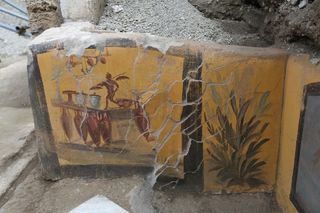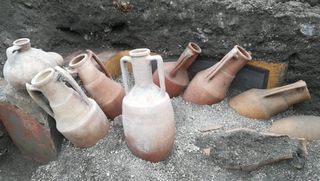Ancient Pompeii 'Fast-Food' Spot Lured Customers with Sexy Logo

Before Mount Vesuvius blasted Pompeii to smithereens in 79, it was possible to grab a bite to eat there at a "fast-food" joint decorated with a handsome sea nymph.
Archaeologists recently uncovered this ancient eatery, known as a thermopolium — a snack bar that served drinks and hot, ready-to-eat food — during an excavation in the ancient city.
And it's far from the only thermopolium. In fact, archaeologists know of about 80 such eateries in Pompeii already — showing that the folks of ancient Pompeii enjoyed munching on easily accessible, savory goodies, just as we do today. [Preserved Pompeii: Photos Show a City in Ash]
"Even if structures like these are well-known at Pompeii, discovering more of them, along with objects which went hand in hand with commercial and thus daily life," helps researchers learn more about daily life in ancient Pompeii, Alfonsina Russo, the interim director at the Archaeological Park of Pompeii, the group that did the research, said in a statement.
This particular thermopolium sits at the intersection of two alleys: Vicolo delle Nozze d'Argento (Silver Wedding Alley) and Vicolo dei Balconi (Alley of the Balconies), which were excavated only recently. The excavation is part of the Great Pompeii Project, which is uncovering and studying a poorly examined area within the city.
A painting on the thermopolium of a scantily clad sea nymph, known as a nereid, immediately caught the eye of archaeologists during the dig. This nereid, who is riding a horse with a sea dragon-like tail, likely served as the eatery's shop sign, the archaeologists working on the project said.
Next to the nereid are paintings of a plant and a man working in a cafe, likely an illustration of a busy day at the snack bar.
Sign up for the Live Science daily newsletter now
Get the world’s most fascinating discoveries delivered straight to your inbox.

Archaeologists also found clay jugs, known as amphorae, in front of the counter. These amphorae look just like the ones in the thermopolium illustration, the excavators noted.
The discovery of this thermopolium "transport[s] us to those tragic moments of the eruption," Russo said.

Life didn't end after Mount Vesuvius erupted. The catastrophe likely killed about 2,000 people, but new research indicates that the rest of the city's 15,000 to 20,000 inhabitants likely settled in nearby cities, including Naples and Cumae. Hopefully, these refugees found more thermopolia in their new neighborhoods.
- Photos: The Bones of Mount Vesuvius
- Pompeii Photos: Archaeologists Find Skeletal Remains of Victims of Vesuvius Eruption
- 24 Amazing Archaeological Discoveries
Originally published on Live Science.

Laura is the archaeology and Life's Little Mysteries editor at Live Science. She also reports on general science, including paleontology. Her work has appeared in The New York Times, Scholastic, Popular Science and Spectrum, a site on autism research. She has won multiple awards from the Society of Professional Journalists and the Washington Newspaper Publishers Association for her reporting at a weekly newspaper near Seattle. Laura holds a bachelor's degree in English literature and psychology from Washington University in St. Louis and a master's degree in science writing from NYU.
Most Popular



